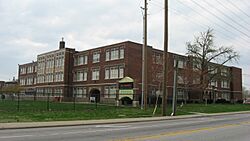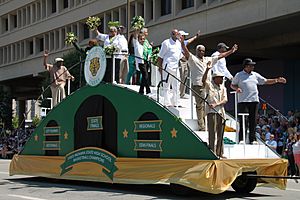Crispus Attucks High School facts for kids
Quick facts for kids Crispus Attucks High School |
|
|---|---|

Front and southern side of the school
|
|
| Location | |
|
1140 Dr. Martin Luther King Jr. St.
, , 46202
United States
|
|
| Coordinates | 39°46′58.39″N 86°10′11.78″W / 39.7828861°N 86.1699389°W |
| Information | |
| Type | Public high school |
| Established | 1927 |
| School district | Indianapolis Public Schools |
| Principal | Lauren Franklin |
| Faculty | 65.00 |
| Grades | 9–12 |
| Enrollment | 1,179 (2023–2024) |
| Color(s) | |
| Athletics conference | Independent |
| Team name | Tigers |
| Website | Official website: http://www.myips.org/cammhs |
|
Crispus Attucks High School
|
|
| Built | 1927 |
| Architect | Harrison & Turnock; Brown & Mick |
| Architectural style | Collegiate Gothic/Tudor Revival |
| NRHP reference No. | 88003043 |
| Added to NRHP | January 4, 1989 |
Crispus Attucks High School is a public high school in Indianapolis, Indiana. It is also known as Crispus Attucks Medical Magnet High School. The school is named after Crispus Attucks, an African American hero from the Boston Massacre. He was killed in 1770 during a protest against British soldiers.
The school first opened on September 12, 1927. It was built near Indiana Avenue, which was a main area for the city's African American community. When it opened, Crispus Attucks was the only public high school in Indianapolis specifically for African Americans. Even after laws were passed to end school segregation, Attucks remained a school mostly for Black students until 1971.
Over the years, the school changed. In 1986, it became a junior high school, and in 1993, it became a middle school. Then, in 2006, it changed back to a high school. It became a special "medical magnet" school. This means it focuses on preparing students for careers in medicine. This was a good idea because it is close to the Indiana University School of Medicine and its hospitals.
Crispus Attucks High School is known for its strong academics and amazing sports teams. Its basketball teams have won several state championships. The school also has the Crispus Attucks Museum, which opened in 1998.
Contents
School History
Building a New School
In the early 1900s, Indianapolis was a city where people of different races often lived in separate areas. Many schools were also separated. Some public high schools did have Black students, but they became very crowded. Because of this, the school board in Indianapolis started talking about building a new high school.
In 1922, there was a lot of interest in building a public high school just for African American students. Some white residents wanted this so their children would not go to school with Black students. However, some African Americans in the community did not want a separate school. They wanted all public schools to be open to everyone. Even with different opinions, the school board decided that all African American high school students in the city would attend the new school.
Early Years of Attucks High School
Crispus Attucks High School was built in an area of Indianapolis known as the Bottoms. This area was close to Indiana Avenue, which was a busy and important place for the African American community.
The school board first wanted to name the new school Thomas Jefferson High School. But many people in the community did not like this name. They asked for it to be changed to Crispus Attucks High School. The board agreed. Crispus Attucks was a brave man who was killed during the Boston Massacre in 1770. At the time, people believed he was a Black man.
When Crispus Attucks High School opened in 1927, all African American teenagers from other high schools in the city were moved there. The school board promised that students at Attucks would get a "separate but equal" education. This idea meant that schools for Black students would be separate but would offer the same quality of education as schools for white students. However, in reality, "separate" was rarely "equal." After Attucks opened, Black students were not allowed to attend any other public high school in Indianapolis. Many people fought against this decision for many years.
Students and Teachers
Crispus Attucks High School was unique because its first principal, Matthias Nolcox, and all its first teachers were African Americans. This made it the only all-Black high school in Indianapolis. Principal Nolcox worked hard to find excellent teachers for the new school. He hired highly educated teachers from Black colleges in the South and from other parts of the country. Many Black educators had advanced degrees but could not find jobs at colleges or universities. This meant Attucks had many very qualified teachers.
The school was first planned for 1,000 students, but this quickly grew to 1,200. On September 12, 1927, Crispus Attucks High School opened with 42 teachers and 1,345 students. It was officially dedicated on October 28, 1927. After Attucks, two other all-Black public high schools opened in Indiana: Gary's Roosevelt High School and Evansville's Lincoln High School.
Overcrowding was a problem from the start. The school board had to use another nearby school building to hold extra students. Russell A. Lane became the principal in 1930. He continued to hire highly educated teachers. By 1934, Attucks had 62 teachers, and many of them had master's or doctorate degrees. This was more than most other high schools in the area.
School Life and Events
Attucks High School offered many different classes. These included subjects like math, science, art, music, and physical education. It also had classes for vocational training, like home economics and industrial arts. Because of its great teachers and many classes, Attucks became known for its excellent academics and successful sports teams.
The Indianapolis Recorder, a local newspaper for the African American community, shared news about school events. This helped make Attucks a special place and a source of pride for the community. The school's sports teams, especially basketball, were very important to the African American community in Indianapolis.
Many famous people visited the school to speak to the students. These visitors included Jesse Owens (a famous athlete), Langston Hughes (a well-known writer), Thurgood Marshall (a future Supreme Court Justice), and George Washington Carver (a famous scientist). These visits encouraged the students and showed support for the school.
1940s and 1950s: Changes and Championships
In the late 1940s and during the civil rights movement of the 1950s and 1960s, ending segregation in schools became a big issue. Even though Indiana passed laws in 1949 to desegregate schools, Attucks remained an all-Black high school. This was mainly because people of different races still lived in separate neighborhoods. During this time, the number of students at Attucks started to go down.
Basketball State Championships
Before 1942, all-Black high schools were not allowed to be full members of the Indiana High School Athletic Association (IHSAA). This meant they could not play in state basketball tournaments. But after 1942, all high schools could join. This allowed Attucks to compete for the first time.
Attucks had amazing success in basketball in the 1950s. Two of its players, Hallie Bryant and Oscar Robertson, became famous. Many Attucks players and coaches have been honored in the Indiana Basketball Hall of Fame.
On March 19, 1955, the Attucks Tigers, led by future professional star Oscar Robertson, won the IHSAA state championship. They beat Gary's Roosevelt High School. This made them the first all-Black school in the nation to win a state title! In 1956, Robertson led Attucks to another championship. They beat Lafayette's Jefferson High School. This team was the first in IHSAA history to finish a season undefeated since the state tournament began in 1911. The Attucks basketball team won its third state championship in 1959. These wins were very important. They showed that Black student-athletes could compete and win against mostly white teams. They also inspired the Black community and served as role models for young people.
1960s–1990s: Changes and New Roles
By the 1960s, the way people lived in Indianapolis started to change. As some Black families moved to different neighborhoods, their children sometimes went to other high schools. This meant that Attucks mostly served children from poorer African American families.
In 1970, a U.S. judge ruled that the Indianapolis Public Schools system was still segregated. Even though a new integrated school campus opened in 1970, the main Attucks building remained segregated for a while. Historians believe that the first white students started attending Attucks's main campus in 1971.
By the 1980s, fewer students were attending Attucks. In 1981, school leaders thought about closing the high school. Even though many people did not want this, Attucks changed from a high school to a junior high school in 1986. Then, in 1993, it became a middle school. The school building was added to the National Register of Historic Places in 1989.
2000s–Present: Medical Magnet School
In 2006, Attucks became a high school again. The school system announced the creation of the Crispus Attucks Medical Magnet. This changed the school from a middle school to a special medical preparatory school for grades 6–12. The school became a medical magnet because it is very close to the Indiana University School of Medicine and its hospitals. The first class to complete the full medical magnet program graduated in 2013.
The basketball program also returned in 2008. On March 25, 2017, the team won the Class 3A state title. This was their first state basketball championship since 1959!
School Building
The Crispus Attucks High School building is very large. It covers an area of two city blocks. It was built in three main parts. The first part, a three-story main building, was finished in 1927. It was designed by local architects Merritt Harrison and Llewellyn A. Turnock. In 1938, a three-story addition and a two-story gym were built. A newer, two-story gym was added in 1966.
The main building and the 1938 addition have a style called Collegiate Gothic or Tudor Revival. They are made mostly of red brick with special details made of terra-cotta and limestone. The newer gym from 1966 is also red brick but has concrete bands. The school building was added to the National Register of Historic Places in 1989.
Crispus Attucks Museum
The Crispus Attucks Museum opened in 1998 inside the school's old auxiliary gym. The museum has four galleries and 38 exhibits. These exhibits share stories about African American history in the local area, the state, the country, and even around the world. The museum often works with groups like Indiana Black Expo and Indiana University. The museum was updated in 2009.
You can visit the museum by making an appointment. It is open Monday through Friday from 9 a.m. to 6 p.m., and Saturday through Sunday from 10 a.m. to 3 p.m.
Famous People from Attucks High School
Notable Alumni
- Oscar Robertson: A legendary basketball player who led Attucks to two state championships and later became a professional star.
- Hallie Bryant: Another talented basketball player from Attucks.
Notable Principals and Teachers
- Matthias Nolcox: The first principal of Crispus Attucks High School (1927–1930).
- Russell A. Lane: Served as principal for many years (1930–1957) and hired many highly educated teachers.
- Ray Crowe: The boys' basketball coach who led the team to back-to-back state championships in 1955 and 1956.
- Bill Garrett: Another successful boys' basketball coach who led the team to a state championship in 1959.
- Merze Tate: An original teacher at Attucks who later became a faculty member at Howard University and a Fulbright scholar.
See also
- List of high schools in Indiana
- List of schools in Indianapolis
- National Register of Historic Places listings in Center Township, Marion County, Indiana


